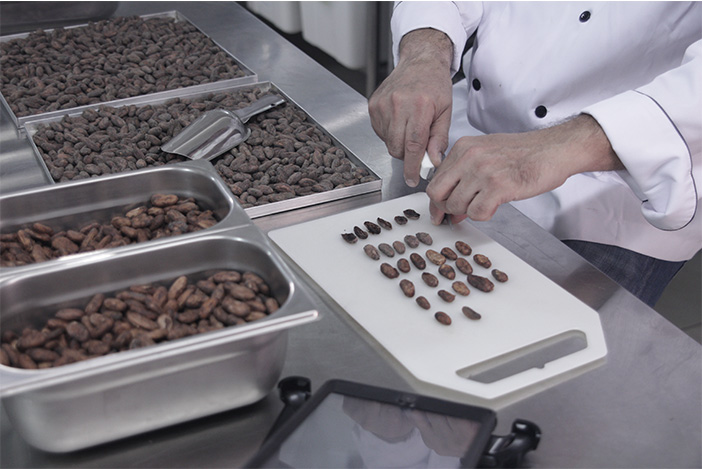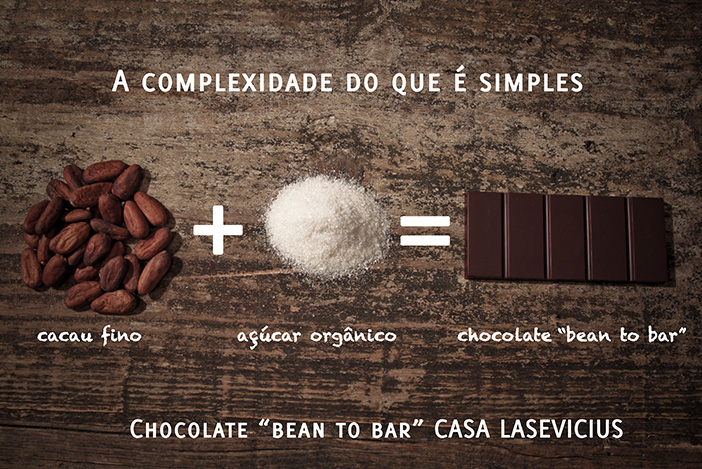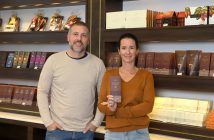Bean-to-bar chocolate privilege the origin of the cocoa and the artisanal preparation
Casa Lasevicius – a Lithuanian last name – is a micro-company producing bean-to-bar chocolates for the brothers Cláudia and Bruno Lasevicius. The chocolate maker at the house is Bruno, a graduated psychologist and responsible for the classical music program by TV Cultura, “Clássicos”, which airs every Saturday at 9:00 p.m.
As a Mozart’s lover, Bruno compares the good chocolates to a true symphony. “Everything has to be absolutely for a great performance to be achieved, as it happens to chocolate.”
He started making alfajores and truffles influenced by his sister who, since college, already dealt with chocolates. As Bruno’s daughter worked for an advertising agency, he soon received numerous orders. Then, to achieve better results, he started researching about the origin chocolates, such as Java, Ecuador and many others. Then, he began the production of bars with Belgian chocolate, the so-called Callebaut.
But he realized that mixing these precious things with milk sweet was a heresy, and on a trip to California, he discovered the bean-to-bar movement. He joined his sister, who developed the packaging, and gradually helped create this new way of eating quality chocolates. “I broke a tendon and needed to be on medical leave. I started to experiment with chocolate and I never stopped,” says Bruno. To date, he maintains the two lines of products: chocolates made with the Belgian chocolate Callebaut and the bean-to-bar ones.
The passion passed from father to daughter and his offspring, Maiana, now living in California, in the city of Santa Cruz, also produces bean-to-bar chocolate, whose brand is Tiny House Chocolates.

Casa Lasevicius – Produção
Casa Lasevicius currently sells to around 50 points of sale in São Paulo, such as Octavio Café, Maha Mantra, King of the Fork, Madalena Café, among others. “We do not want to grow too much or in a disorderly manner. We believe in the art of chocolate, where everything is handcrafted and in small batches, from chocolates to packaging. And we use neither preservatives nor industrial additives,” explains Bruno.
A difficult onset
When he made contact with the bean-to-bar movement in California, Bruno did not know how difficult it would be to return to Brazil and get suitable equipment. Of course, he could not find it and had to use all his creativity to develop them.
He improvised, and by one of these amazing coincidences, in Bahia, cocoa producers were timidly producing fine cocoa. The first supplier he met was a Frenchman who had been living in Brazil for 15 years, Frederic, from the Gran Sol farm, and who was selling his cocoa at Vila Madalena. “Actually, I was very lucky, because his cocoa was really good,” he recalls.
Then he found the Magalhães family farm, also from Ilhéus, from Lajedo do Ouro. “To date, I work with them, even in the last bean-to-bar Brazil, our chocolate was awarded”, says Bruno.

Chocolate “Bean to bar” Casa Lasevicius
At that point, things began to improve: the producers themselves took the initiative to look for Casa Lasevicius to sell their cocoa. “At that time I met another Frenchman, David Pujol, from the Ouro Verde farm, near Ilhéus, which has a truffle factory in France. He is an exclusive supplier of Casa Lasevicius.
Currently, Casa Lasevicius buys cacao from the Brazilian regions, such as Bahia, Espírito Santo and Amazonia. It has in its catalog more than 20 labels, and to reach these results, Bruno tests the roast, the variety of cocoa and its percentage, fermentation, other ingredients and any idea can become a fairly unusual product, such as infused chocolate of lice ants, harvested by people from the Brazilian Amazon, on the border with Venezuela and Colombia. The ants are collected from within the wood trunk and as they feed on lemongrass, when you bite it, you will notice an explosion of flavors and the accentuated taste of the lemon grass. It is deliciously refreshing!

Chocolate Artesanal – Casa Lasevicius
And despite all the difficulties, Casa Lasevicius, in these three years of activities, has grown significantly. “In the first year, we produced 30 kg of bean-to-bar chocolates. In the second year, our production doubled, and in the third year, we reached two tons,” says Bruno.
The next steps are to move the factory and, perhaps, open a chocolate shop, next to a coffee shop, another passion of Bruno, who likes so much specialty coffees that he keeps a small collection of espresso machines at home. “I also wish to explore the food service market, a very interesting path, too”, he confides.
How the bean-to-bar movement began
The bean-to-bar movement was born in retaliation for consumers of the American chocolate brand called Scharffen Berger, which produced cocoa-based chocolate and was bought by Hershey, in 2005. Aware of the significant deterioration in product quality, the old brand consumers decided to research technologies to produce chocolates of origin by themselves, which ended up creating a new market and opening up for small producers. Bean-to-bar chocolates carry only cocoa and sugar in their compositions.
And it is meticulously manufactured, on a small scale, respecting the time of each of the stages of elaboration, with knowledge of the characteristics of the cocoa and the most adequate preparation techniques to reach the desired chocolate.
Fotos e vídeos: Clodoir de Oliveira



